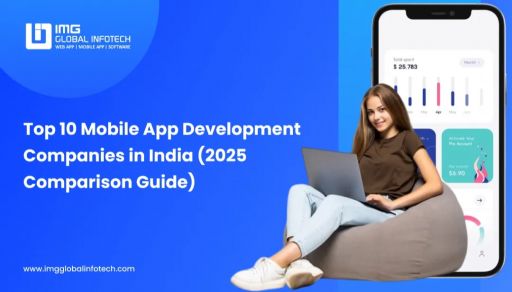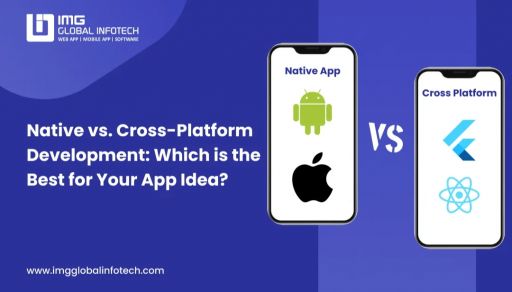Top Android Application Security Best Practices To Follow In 2025
Neeraj Rajput
Jul 15, 2025

As mobile technology continues to dominate the digital world, Android applications have become essential tools for businesses, users, and developers alike. However, with growing reliance on mobile apps comes an increased risk of cyber threats, data breaches, and malicious attacks targeting Android platforms. From financial apps and healthcare tools to ride-hailing services and ecommerce platforms, no app is protected.
In 2025, Android app security is no longer optional, it's necessary. With users entrusting apps with personal, financial, and behavioral data, ensuring a secure user experience is key to maintaining trust, credibility, and compliance. Mobile app developers and business owners must adopt proactive security measures throughout the mobile app development lifecycle to minimize vulnerabilities and protect their users and reputation.
In this blog, we’ll explore the top Android application security best practices that every app owner, developer, or tech leader must follow to stay ahead of evolving cyber threats and deliver secure, high-performance mobile solutions.
Why App Security Should Be a Top Priority for App Owners?

-
Protects Sensitive User Data
Android apps often handle personal information, financial details, and location data, making them prime targets for cyberattacks.
-
Prevents Data Breaches & Financial Loss
Security vulnerabilities can lead to costly breaches, resulting in monetary losses and legal complications.
-
Safeguards Brand Reputation
A single mobile app security incident can damage user trust and permanently harm your brand image.
-
Ensures Regulatory Compliance
Helps meet data protection laws like GDPR, HIPAA, and other region-specific regulations.
-
Blocks Malware & Unauthorized Access
Android or iOS apps are commonly targeted by malware and reverse engineering attempts, android app security best practices reduce this risk.
-
Builds User Trust & Retention
Users are more likely to continue using apps that keep their data secure and offer transparent protection measures.
-
Maintains App Store Eligibility
Google Play enforces strict security standards, non-compliant apps risk removal or suspension.
-
Supports Long-Term App Success
A secure android app development is scalable, trusted, and better positioned for long-term business growth and market competitiveness.
Major Security Threats Facing Android Applications

With Android being the most widely used mobile operating system globally, it naturally becomes a high-value target for hackers and malicious actors. The openness of the platform, combined with rapid mobile app development cycles, often leads to overlooked vulnerabilities. To create secure, scalable, and trustworthy applications, developers and app owners must understand the most common and dangerous threats plaguing Android app security today.
1. Insecure Data Storage
Many apps store user information, such as login credentials, tokens, or personal data on the local device. If this data is stored in plain text or without proper encryption, it becomes a goldmine for attackers, especially if the device is lost, stolen, or rooted. Without using secure mechanisms like Android Keystore or encrypted SharedPreferences, android app developers risk exposing users to identity theft and fraud.
2. Unsecured Network Communication
Apps that communicate with backend servers over unencrypted channels (like HTTP instead of HTTPS) are extremely vulnerable to man-in-the-middle (MITM) attacks. Hackers can intercept, alter, or steal data transmitted over insecure networks, including login details, payment information, or API keys. Failing to implement SSL/TLS encryption puts both the app and its users at significant risk.
3. Reverse Engineering
Since Android apps are compiled into APK files that can be easily decompiled, attackers can reverse engineer the app to understand its structure, extract sensitive logic, or discover vulnerabilities. Without using tools like code obfuscation or ProGuard, malicious actors can even clone or republish your app with embedded malware.
4. Inadequate Authentication Mechanisms
Weak or misconfigured authentication systems allow attackers to gain unauthorized access to user accounts or admin-level privileges. iOS app developers that don’t enforce strong password policies, use outdated authentication protocols, or skip multi-factor authentication are more susceptible to brute-force attacks, credential stuffing, or session hijacking.
5. Code Injection and Exploits
Poorly validated input or insecure coding practices can allow attackers to inject malicious scripts or commands directly into the app or backend. This includes SQL injection, JavaScript injection (XSS), or command-line injection, leading to data leakage, unauthorized control, or corruption of application functionality.
6. Malware Injection via Third-Party Libraries
Many android app development company rely on open-source libraries and third-party SDKs for faster development. However, these external dependencies may contain known vulnerabilities or malicious code that compromises the entire app. If not carefully vetted or regularly updated, these components can serve as backdoors for attackers.
7. Improper Session Handling
Sessions that are not securely managed can be hijacked by attackers. Common issues include session tokens that never expire, tokens stored in insecure locations, or the lack of session invalidation after logout. Such oversights enable unauthorized access, especially in shared or public device environments.
8. Use of Outdated Libraries and SDKs
Using older versions of libraries, plugins, or SDKs can expose the app to known vulnerabilities that have already been patched in newer versions. Developers who do not keep dependencies up to date risk having security holes that are well-documented and easily exploitable by hackers.
9. Rooted Device Exploits
Rooted Android devices remove many of the built-in security controls provided by the OS. If your app doesn't detect rooted environments, it may unknowingly run in compromised conditions, allowing attackers to access app storage, bypass authentication, or inject malicious scripts directly.
10. Over-Permissioned Applications
When apps request more permissions than they actually need, such as access to contacts, camera, or storage they increase the attack surface unnecessarily. Over-permissioning can be exploited by malware or other apps with escalated privileges, especially if permissions are granted automatically or without user awareness.
Best Practices for Android Application Security
These days mobile apps have become central to our daily lives, enabling banking, transportation, shopping, healthcare, and even government services, monetary security is no longer just a backend concern. For Android applications development, the threat landscape continues to evolve, making security an integral part of the development lifecycle.
Whether you're a startup building an MVP or an enterprise managing a widely used app, applying robust security practices can protect your users, secure your data, and uphold your brand reputation. Here are the most critical Android app security best practices every developer and app owner must prioritize:
1. Secure Your Code from the Ground Up
-
Start with secure development principles. Write clean, maintainable code with clear boundaries between modules to limit the impact of security breaches.
-
Obfuscate your code. Tools like ProGuard, R8, or DexGuard make it harder for attackers to reverse engineer APKs.
-
Use ProGuard rules to remove unused classes and optimize the bytecode, reducing the attack surface.
-
Avoid hardcoded secrets such as API keys, passwords, or tokens directly in the source code.
-
Monitor your codebase continuously for vulnerabilities using tools like FindBugs, PMD, or SonarQube.
2. Enforce Secure Communication Protocols
-
Use HTTPS for all communication between the app and the server, and ensure that your SSL/TLS certificates are valid and up to date.
-
Implement SSL pinning to bind your app to a specific server certificate and prevent spoofing or MITM attacks.
-
Disable HTTP fallback mechanisms and avoid mixed content (HTTP + HTTPS) in WebViews or embedded browsers.
-
Validate all incoming data from network sources before processing or displaying it.
3. Robust Authentication & Authorization Mechanisms
-
Adopt modern authentication standards like OAuth 2.0, JWT, or Firebase Authentication.
-
Add Multi-Factor Authentication (MFA) where applicable to provide an additional security layer.
-
Limit session durations and automatically log users out after a period of inactivity.
-
Use biometric authentication (fingerprint, facial recognition) for enhanced user identity verification.
-
Avoid storing passwords or tokens locally, use the Android Keystore for sensitive authentication data.
4. Apply the Principle of Least Privilege
-
Only request permissions that are absolutely necessary. For example, if your app doesn't require access to contacts or SMS, don't request them.
-
Break permissions into smaller components and use runtime permission prompts to explain why you need them.
-
Use Android’s scoped storage model to minimize unnecessary access to external storage.
5. Encrypt Sensitive Data – Both in Transit and at Rest
-
Encrypt sensitive data using strong algorithms like AES-256 or RSA before storing it locally.
-
Use Android Keystore API to generate and manage cryptographic keys securely.
-
Avoid saving data in SharedPreferences or SQLite databases unless it is encrypted.
-
Always encrypt communications over the network using TLS v1.2 or above.
6. Regular Security Testing and Auditing
-
Conduct periodic penetration testing using third-party professionals or internal red teams.
-
Run static and dynamic code analysis with tools like MobSF, Veracode, Burp Suite, and OWASP ZAP.
-
Perform threat modeling at each development phase to anticipate attack vectors.
-
Test your app in production-like environments before going live to identify misconfigurations or performance-related vulnerabilities.
7. Detect and Block Rooted Devices and Emulators
-
Rooted devices bypass many of Android’s built-in protections, making your app more vulnerable to tampering.
-
Use libraries like SafetyNet, RootBeer, or Xposed detection tools to block unauthorized device access.
-
Disable debugging and developer options for production builds to prevent reverse engineering.
8. Vet, Monitor, and Maintain Third-Party Dependencies
-
Avoid unnecessary third-party SDKs or libraries, especially those with unclear origin or unsupported updates.
-
Review the permissions and data access scope of every SDK integrated into your app.
-
Track known vulnerabilities (CVEs) using tools like Snyk, WhiteSource, or Dependabot.
-
Use dependency version locking and audit dependency changes with every new release.
9. Implement Secure Session Management
-
Use short-lived session tokens and refresh them periodically.
-
Store session data only in zecure, encrypted storage, never in plain text or cache.
-
Invalidate sessions on logout or after prolonged inactivity.
-
Protect against session fixation attacks by regenerating tokens after login.
10. Stay Up to Date with Security Patches and Android Guidelines
-
Update your app regularly to fix any vulnerabilities discovered in the code or in third-party tools.
-
Follow the latest Android security best practices from Google’s official documentation and Android Developers Blog.
-
Adapt quickly to new Android OS changes, such as scoped storage, background execution limits, and privacy policy requirements.
-
Encourage users to update the app by prompting them and offering in-app update options.
Conclusion
In today’s digital world, where mobile apps handle everything from payments to healthcare data, Android application security practices are no longer optional, it’s a necessity. As cyber threats grow more sophisticated, app owners, product managers, and developers must treat security as a continuous process, not a one-time task.
By implementing the best practices covered in this blog, from secure coding and encryption to real-time threat detection and safe session management you significantly reduce your risk exposure and enhance user trust. Investing in robust security not only protects your business but also ensures long-term success in an increasingly competitive mobile ecosystem.
Don't wait for a breach to act, start building secure, scalable, and future-ready Android apps today.
Neeraj Rajput is the co-founder of a leading IT company with over a decade of experience in technology consulting, product development, and digital transformation. With a passion for solving complex business challenges through smart tech solutions, he shares insights on innovation, leadership, and the evolving IT landscape












